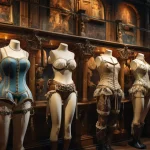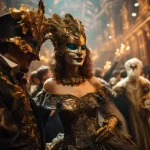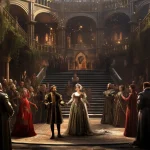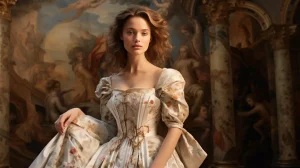
A Journey into the World of Opulence and Elegance
Ah, the Renaissance— a period of rebirth, where art and culture flourished like never before. 🎭 Can you imagine the cobblestone streets echoing with laughter, sonnets, and the subtle rustling of rich fabrics? It was an age that gave us the works of Da Vinci, the poems of Shakespeare, and some mighty fine tunes. But today, we’re not just talking about what hung on the walls of a gallery or the words penned in aged books; we’re talking about what people actually hung on themselves. Yes, dear friends, prepare to immerse yourself in the lavish universe of Renaissance Gowns. 🌹
Picture this—a gown, but not just any gown. This is a garment sewn with the threads of social standing, woven with cultural significance, and embroidered with the artistry of a thousand dreams. You see, in the Renaissance, a gown wasn’t merely a piece of fabric you draped over your shoulders; it was your calling card, your statement to the world. It declared who you were, what family you belonged to, and sometimes, it even whispered secrets about your personal tastes and quirks. 😌
Each fold and pleat, each carefully chosen hue, and each glinting gemstone that adorned these magnificent garments were more than mere fashion choices; they were a celebration of life itself! If clothes make the man, then these gowns truly sculpted the essence of womanhood during the Renaissance, highlighting the grace, power, and beauty that was often both understated and underestimated. ✨
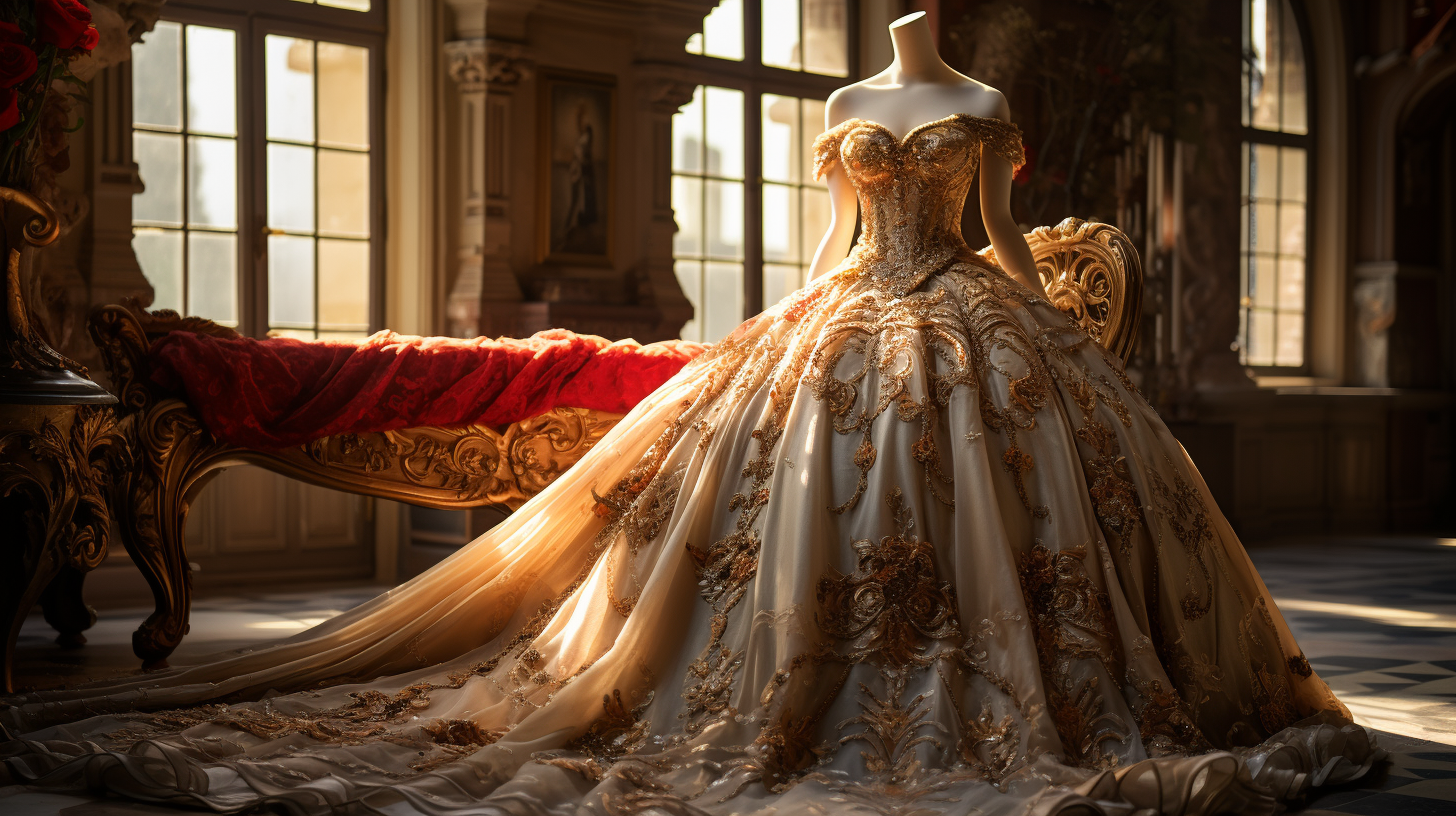
Image: capturing the full grandeur of a Renaissance gown—each intricate
detail, from sumptuous fabrics like velvet and silk to the fine embroidery
laced with small gemstones.
So, sit back, relax, and let me take you on a stroll down the memory lanes of yore, where each stitch is a story, and each garment a gateway to a world long gone but never forgotten. 🌌
When the World Was Waking Up: The Renaissance Era
Ah, the Renaissance, a true explosion of the human spirit, mind, and creativity. Imagine, if you will, walking through an Italian city-state during the 14th to 17th centuries. You’d hear lutes strumming sweet melodies, smell fresh ink as books are printed for the first time on a massive scale, and see masterpieces of art and sculpture at every corner. 🎨 But it’s not just the fine arts that saw an unparalleled revival; fashion, too, went through a metamorphosis. Here’s a quick overview to help you soak up the atmosphere of that time—a moment in history when the very fabric of society was, well, fabulous fabric. 🤩
The Setting of the Renaissance
The period known as the Renaissance began primarily in Italy, spreading its wings to the rest of Europe eventually. It was as if the world had just woken up from a long slumber. Suddenly, there were advancements in science, the arts, philosophy, and, believe it or not, fashion. You see, this renewed focus on individuality and humanism found its way into every thread and stitch of the garments of that period.
Suggested Image: Imagine a photorealistic scene of a bustling Italian square during the Renaissance. Scholars, artists, and the fashionably elite gather, all adorned in garments that capture the era’s essence. The colors should be vibrant yet slightly weathered, like a painting you’d find in a grandparent’s attic.
Fashion as a Reflection of Societal Changes
It’s hard to separate the culture of the Renaissance from the clothes people wore. With newfound wealth, thanks to trade and commerce, cities became places of incredible opulence. People were no longer just survivors or mere pawns in feudal systems. They were individuals with a sense of self, and they wanted their clothes to express that individuality. The fashion of the Renaissance, replete with its velvets, silks, and jewels, was a canvas upon which society painted its aspirations, dreams, and sometimes, its vanities.
Alright, now that you’ve got the lay of the land, let’s get into the nitty-gritty of what makes these Renaissance gowns so incredibly spellbinding. 🌟
Unveiling the Enigma: Anatomy of a Renaissance Gown
You know, every masterpiece has its elements, its pieces that make up the whole. The Sistine Chapel has its frescoes, a guitar ballad has its chords, and in the same vein, a Renaissance gown has its components that, when sewn together, tell a tale of elegance and intricacy. 🎭
The Backbone: Basic Components
When you look at a Renaissance gown, you’re not just staring at a single piece of clothing. Nah, you’re looking at a harmonious blend of various elements. First off, there’s the bodice, snug and fitted, like the binding of a beautiful tome of poetry. Then, the sleeves—detachable, and often with contrasting fabric—make their own statement. The voluminous skirts, meanwhile, sweep the floor in a majestic flow, giving the wearer an almost ethereal look. And let’s not forget the farthingale, a hooped skirt that gives the gown its famous bell-like shape.
Threads of Splendor: Description of Materials Commonly Used
If these gowns were songs, then the fabrics would be their notes—each chosen for its tone and resonance. We’re talking about rich velvets that are as deep as the midnight sky, sumptuous silks that feel like whispers against the skin, and brocades woven with threads of gold and silver. These weren’t just garments; they were symphonies of texture and color.
Suggested Image: A photorealistic breakdown of a Renaissance gown, showing its various components like the bodice, sleeves, skirts, and farthingale, each annotated with descriptions. The materials, whether it’s velvet, silk, or brocade, should appear lush and rich in color.
So, now that we’ve laid down the layers of what makes these gowns true masterpieces, it’s time to dig even deeper. Let’s delve into the intricate embroidery that not only embellished these garments but also told stories, from symbolism to influence by the courts. Hang tight; we’re about to get real artsy here. 🎨👗
The Language of Embroidery: Where Every Stitch Tells a Story
Imagine taking a brush to a canvas, but instead of paint, you’re using threads and needles. That’s the world of embroidery, my friends—a space where craft meets art, and each stitch adds a word to an unfolding story. In the realm of Renaissance gowns, embroidery wasn’t just decoration; it was dialogue. 🎨
Symbolism in Stitch
Think of embroidery as a kind of visual shorthand. Back in the Renaissance, the kinds of stitches, their colors, and the patterns they formed carried meanings. Take the rose, for instance—a popular motif often found gracing the bodices or hemlines. The rose wasn’t just a flower; it was a symbol of love, beauty, and sometimes even politics. Just as how Shakespeare’s words held layers of meaning, so did the threads stitched into these gowns.
Royalty and Its Influence
Ah, when you’re talking about top-tier embroidery, you can’t ignore the impact of royalty. Monarchs and courtiers had the best of the best, and their gowns were the epitome of opulence. Queens like Elizabeth I of England took this to another level, donning gowns embroidered with pearls and semi-precious stones. Those weren’t just clothes; they were statements of power and authority, commanding respect in every room they entered.
Suggested Image: A photorealistic close-up of intricate Renaissance embroidery, perhaps even contrasting a royal gown with a more common one. Annotations should point out the kinds of stitches, the symbolism of motifs like the rose, and perhaps even the types of materials like pearls or semi-precious stones that might be included in the embroidery.
Well, that was our poetic sojourn into the embroidered worlds that rest on the surface of Renaissance gowns. But the journey isn’t over. Next, we’re diving into the structural ingenuity beneath all that beauty. We’re talking farthingales and stays—those invisible helpers that crafted the unforgettable silhouettes of the Renaissance. Hold onto your seats; the next chapter’s gonna be a captivating one. 🌹👑
Crafting the Silhouette: The Importance of the Farthingale and Stays
Ah, yes, beneath the symphony of embroidered tales and the richness of velvet and silk, there exists another world. A world of structure and silhouette, brought to life by unsung heroes of fashion: the farthingale and stays. In the era of Renaissance gowns, these elements were indispensable, working quietly in the background to create the grand spectacle that we all admire.
The Farthingale’s Function
Consider the farthingale—the architectural foundation of many a Renaissance gown. It was often a conical or wheel-like structure, made from materials like willow or whalebone. Imagine an elegant woman, her gown expanding around her like a bell or a flower in bloom. This was no magic trick; it was the artistry of the farthingale. This unseen marvel lifted layers of heavy fabric, providing both form and function, elevating a simple gown into a walking piece of art.
The Anatomy of Stays
While the farthingale shaped the lower half, it was the stays that sculpted the torso. Crafted meticulously, often with strips of whalebone or reeds, these stays were the precursors to the modern corset. They molded the body, cinching the waist and elevating the bust, to fit the societal standards of beauty and grace. In an age without Lycra or elastic, these stays were the engineering marvels that contoured the body into desirable shapes.
Suggested Image: A photorealistic depiction of the farthingale and stays, perhaps as an X-ray view beneath a gorgeous gown. The farthingale could be seen as a wheel-like structure around the lower half, and stays could be seen sculpting the upper torso. Annotations may highlight the materials used, like whalebone or reeds, to give a sense of the craft involved.
And there we have it. We’ve journeyed beneath the visible splendor to the unsung heroes that lend structure to the art. Next, we shall turn our attention to an invisible thread that weaves through the fabric of these gowns: the societal norms and laws that dictated what could be worn, by whom, and when. It promises to be a compelling narrative, so stay tuned. 🌼🏰
The Social Tapestry: Class and Sumptuary Laws
The tale of Renaissance gowns is deeply woven into the fabric of the society from which they sprang. They were not mere garments but spoke volumes about the class stratification and the sumptuary laws that were designed to maintain it. Let’s dissect these intricate weaves.
Dressing the Class Divide
In the Renaissance period, clothing was not just about covering one’s body or showcasing one’s aesthetic tastes. It was a marker of social status. Fabric, color, length, and decoration—every element was meticulously chosen to signify one’s social standing. The poor were often relegated to wearing plain wool, while nobles draped themselves in luxurious fabrics like silk and velvet. Even the dyes used were indicative of class; vibrant colors like red and purple were expensive to produce and were hence restricted to the higher echelons of society.
The Power of Sumptuary Laws
The governing bodies of the time instituted sumptuary laws that dictated what each class could and could not wear. These laws were not merely aesthetic mandates but socio-political tools to reinforce class distinctions and prevent upward social mobility. Failure to adhere to these laws often resulted in public humiliation and financial penalties, making fashion an arena regulated not just by personal choice but by legal decree.
Suggested Image: A photorealistic painting depicting a public square in the Renaissance period, where people of different classes are seen wearing various types of clothing. One could see the stark contrast between the rich and poor through their gowns and garments. Annotations could elucidate the social meaning behind each fabric and color.
Having deconstructed the invisible, yet palpable, threads of social norms and laws that shaped Renaissance fashion, our next venture will be into the tactile world of ornate details that bedeck these garments. It is in these very details that the essence of Renaissance beauty lies; as if each bead and stitch were a word in a love letter to an epoch of exuberance and grandiosity.
The Alchemy of Beauty: Embroidery, Beads, and Lace
Ah, now we’re diving into the part that makes your heart sing—a Renaissance gown’s intricate details. We’re talkin’ about the craftsmanship that elevates these garments into works of art. So, come closer, let’s revel in the delicate language of stitches, beads, and lace.
The Story of Stitches
Embroidery in the Renaissance wasn’t just a pastime; it was a high art form. Imagine skilled artisans laboring over fabric for countless hours, threading gold and silver wires into motifs that were deeply symbolic. From royal emblems to mythological creatures, every stitch told a tale, contributing to the garment’s narrative.
Now, if you’re new to this, don’t rush. Take your time to learn the basics: satin stitch, stem stitch, chain stitch. Each has its own character, its own flair, and when used in combination, they breathe life into a piece of fabric. It’s like making music but with threads.
The Glossary of Beads
Beads were like the punctuation marks in the poetic ensemble of Renaissance fashion. They were made from all sorts of materials—glass, bone, ivory, even gemstones. Ever heard of the “Paternoster beads”? These were especially popular in religious garments and were often used to invoke a sense of devotion and piety.
Suggested Image: A photorealistic rendering of a close-up of a Renaissance gown, highlighting intricate embroidery patterns and a variety of beads. Annotations could detail the specific types of stitches and bead materials used.
The Intricacies of Lace
You know, lace is often misunderstood. Some folks think it’s just there for frills. But in the Renaissance, crafting lace was a labor-intensive process. It wasn’t just decorative but served to showcase the wearer’s wealth and social standing. Bobbin lace, needle lace, cutwork, oh my! Each type had its own technique, requiring specialized tools and immense skill.
Lace wasn’t just sewn into the hems and cuffs but was ingeniously integrated into the garment’s overall design, often serving as a luxurious backdrop to embroidered masterpieces. So, the next time you see lace, remember: it’s not just a pretty face.
So, we’ve dug deep into the ornate splendor of embroidery, beads, and lace. Up next, we’ll explore the very framework that gives these garments their defining shapes and contours. It’s like the bones of the outfit, man. We’ll get into cuts, drapes, and silhouettes, and see how these elements are like the architects of style. Stay tuned.
The Geometry of Style: Cut, Drape, and Silhouette
Welcome back, friends. We’ve wandered through the wonders of embroidery, beads, and lace, all the rich ornamentation that dazzles the eyes. But let’s not forget, it takes a sturdy frame to hang all that beauty on. So, today, let’s talk about the bones of the ensemble: cut, drape, and silhouette. This is where fashion finds its form.
Cutting to the Chase
So you’ve got this lush fabric, right? Maybe it’s a fine silk or a heavy brocade. Before the first stitch, before the first bead, someone’s gotta make the first cut. This stage is crucial. Cut it wrong and you’re in for a world of hurt. Cut it right and it’s like a symphony, every piece harmonizing with the rest.
Renaissance tailors were like the Michelangelos of fabric, turning flat, lifeless textiles into 3D works of art that could embrace a human form. Now, when it comes to Renaissance cuts, you’ve got your basics like the bodice, sleeves, and skirt, but the nuances—ah, the nuances—are where the magic happens. Ever heard of a “farthingale”? It’s an undergarment that helped shape skirts, giving them that distinct silhouette.
The Flow of Fabric
Draping, man, it’s where the fabric finds its groove. You could have the best textile in the world, but if it doesn’t fall just right, well, you might as well be wearing a burlap sack. The art of draping is understanding how fabric interacts with movement and the body’s natural contours. It’s got to flow like a river, gentle yet purposeful.
A well-draped garment complements every part of you. When you walk, it walks with you; when you dance, it dances. In the Renaissance, the preferred fabrics were those that had both weight and flexibility. Think velvets and heavy silks that were rich enough to hold embroidery yet flexible enough to allow for easy movement.
The Shape of Elegance
We’re all familiar with the hourglass silhouette of the Renaissance. But how did they achieve this ideal form? Through clever construction and sometimes even cleverer undergarments. Corsets cinched the waist, while farthingales and bum rolls enhanced the hips and bust.
Remember, these shapes weren’t just fashion whims. They were symbols, speaking to societal ideals of beauty, wealth, and even morality. To don a garment of this magnitude was to wear one’s status, aspirations, and even ethics for all to see.
Suggested Image: An illustrative diagram of a Renaissance gown from various angles, showcasing the cuts, drapes, and silhouette. Labels point out the intricate elements that contribute to the overall shape, such as the bodice cut, the drape of the skirt, and the farthingale underneath.
Well, we’ve taken quite a trip through the craft of shaping these amazing garments. Next time, we’ll dig into the symbolism embroidered into the fabric of Renaissance fashion. These aren’t just clothes, folks—they’re cultural statements. So stay tuned. We’ve got plenty more threads to unravel.
Symbols and Society: How Fashion Reflects Culture
We’ve delved into the intricate details of cut, drape, and silhouette, appreciating the craftsmanship that transforms textiles into wearable art. Yet, the fascinating journey doesn’t end there. To fully comprehend the scope of Renaissance fashion, we must explore its connection with the larger societal framework. In essence, the clothing of this era serves as a visual representation of social values, power structures, and even ethical beliefs.
Status in Stitches
The fashion of the Renaissance era was not merely an aesthetic endeavor; it was a social language, codifying one’s standing within the intricate tapestry of society. From the luxurious silks worn by the nobility to the humble wool garments of commoners, fabric was a herald announcing one’s social rank.
Luxurious fabrics like silks, velvets, and fine wools were not merely the purview of the wealthy for their aesthetic allure. These fabrics were expensive to produce and import, hence their exclusivity served as a demarcation of wealth and nobility. Simpler fabrics like linen and wool were accessible to the general populace and often dyed in colors that were easily available, further distinguishing social classes.
The Morality of Material
The materials used in Renaissance fashion were not mere utilitarian choices; they bore a weighty significance. For instance, the color and decoration of a garment could be perceived as a reflection of one’s moral character. Darker hues like blues and blacks were often worn by men of the church, symbolizing piety and somberness. Bright reds and golds were associated with the courts and indicated a worldly orientation.
Furthermore, modesty in dress was extolled as a virtue, especially for women. Thus, garments that concealed rather than revealed were seen as morally superior. Intricate but conservative embroideries adorned the clothing of the virtuous, serving as both aesthetic and ethical embellishments.
Cultural Cross-Stitching
The Renaissance was a period of exploration and discovery, not just in the scientific sense but also culturally. As trade routes opened up, we observe a melange of stylistic influences merging into the fashion of this period. For example, the Spanish farthingale had its origins in Moorish fashion, and intricate Venetian lacework was inspired by techniques from the East.
In essence, each garment is a patchwork quilt of global influences, reflecting the societal changes ushered in by greater connectivity. It’s not just a matter of aesthetic appreciation; it’s a testament to the interweaving of different cultures and societies.
Suggested Image: A Renaissance painting depicting a social gathering, with labels pointing out various elements of the guests’ clothing that reflect their social status, moral character, and cultural influences.
We’ve explored the depth of symbolism interwoven into the fabric of Renaissance fashion. In our next installment, we’ll examine how elements of this rich history resurface in modern fashion trends. We’ll also delve into the lasting impact that these stylistic choices have had, reverberating through the annals of time right up to the present day. Stay tuned.
The Future Echoes the Past: Trends Revisiting Renaissance
So, we’ve gone through the labyrinth of Renaissance fashion, touching on the fabrics, the cuts, and even the way society was mirrored in the clothes folks wore. But, you see, time has this beautiful quality—what’s past is often prologue. Now we’re stepping into the present, where shades of Renaissance fashion are making a comeback, showing up in modern trends, cinema, and the everlasting impact that just doesn’t fade away.
Modern Revivals
Take a walk through the latest fashion weeks, whether it’s Milan or New York, and you’ll find Renaissance-esque vibes sneaking their way into contemporary couture. We’re talking puffed sleeves, velvet fabrics, and those high waistlines that would make a 16th-century duke nod in approval. Designers are marrying technology with tradition—imagine laser-cut lace patterns on a gown that takes its silhouette straight from the Medici family album.
It’s more than just a passing trend; it’s the fashion world’s acknowledgment that the past holds valuable lessons in craftsmanship, technique, and even social consciousness.
Influences in Cinema
Switch on your favorite streaming service, and boom! The Renaissance has made its way to the big screen as well. From epic dramas to fantasy series, the opulence and intricate detailing of the era have caught the imagination of filmmakers. Characters decked out in corsets, ruffs, and sumptuous brocades make the narrative visually rich, while also hinting at social norms and values that still resonate today.
It’s not just costume dramas or period pieces that borrow from the Renaissance. Even superhero movies, where the stakes are high and the outfits often otherworldly, take cues from this significant era, infusing characters with an air of grandiosity and nobility.
The Everlasting Impact
And now, let’s talk about something really special—the never-ending ripple effect of Renaissance fashion. It’s not just in the threads we wear or the movies we watch. It’s in the way we perceive aesthetics and value craftsmanship. Even the modern ethical fashion movement, with its focus on sustainability and artisanal craft, echoes the Renaissance’s respect for the skill and artistry involved in clothing creation.
That respect is carried on in schools where fashion design is taught, in museums that curate vintage garments, and in every thread of the fabric of our modern fashion discourse.
Suggested Image: A split-screen image depicting a Renaissance painting on one side and a modern-day fashion show on the other, highlighting the similarities in garments.
There you have it. We’ve surfed the timeline from Renaissance to now, catching waves of trends, influences, and impacts. All that’s left is to tie these threads together in a concluding narrative, where we’ll contemplate the intriguing blend of history and modernity in the vast tapestry of fashion. Hold onto your hats, because this is where it all comes together.
The Woven Tapestry: Stitching Time, Culture, and Threads
Well, here we are at the end of this intricate journey, folks. But the end is also a beginning—of understanding, appreciation, and perhaps your own sartorial choices. You’ve got to ask yourself, why is any of this relevant? And the answer lies not just in the past or the present but in the eternal dialogue between the two. So, let’s tie it all up, shall we?
The Weave of History and Modernity
You see, fashion is not unlike your favorite dish. It borrows from multiple cultures, periods, and mindsets to offer something that comforts, excites, and sometimes even challenges the palate. The Renaissance might be a far-off echo, but its resonance is felt every time you put on a garment that values quality over mass production, or when you celebrate individuality over a homogenized look.
It’s in the seamstress who spends hours, days even, crafting a lace pattern that hasn’t been seen for centuries. It’s in the fashion student who ditches the trend reports and delves into history books. And let’s not forget the impact it has on cinema and visual storytelling—where the weight of a single garment can set the tone for an entire world.
Personal Insights
And what about you? Where do you fit in this grand tapestry? Well, that’s the million-dollar question. Perhaps you’re the person who’ll incorporate a splash of Renaissance flair in your next outfit. Or maybe you’ll be the one who digs deeper into the cultural context behind a specific garment, forever enriching your viewpoint and conversations. Whatever your path, remember this: fashion is an ever-evolving dialogue among cultures, generations, and yes, you. Your role? Be an informed participant, not just an observer.
Suggested Image: A collage or mosaic that consists of fabrics, designs, and cultural elements, symbolizing the diverse influences that shape our fashion choices.
That’s a wrap. We’ve journeyed through the archives of history, strolled down the runways of the modern world, and hopefully, opened a few doors in your mind. I hope you’ll leave this space a little more curious and much more appreciative of the strings and stitches that weave the grand tapestry of fashion. No next section, folks. This is where we part ways—until the next thread pulls us back together.



